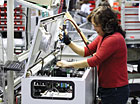
A worker at the Danfoss Drives facility in Loves Park, Ill., does her part in the assembly of a frequency drive.
There was a sense of past and future in the two-day event at the Danfoss Drives facility in Loves Park, Ill., that is in a metropolitan area of 300,000, about 85 miles northwest of Chicago. This year marks the 40th anniversary of the company’s production of variable-frequency drives. And this month there is a planned groundbreaking for an expansion project that in one year will double the Loves Park site to 250,000 square feet. This will allow the company to continue to expand its production of drives greater than 90 kW.
Sven Ruder, global president of Danfoss Motion Controls division, told the media from North and South America as well as the United Kingdom and Europe, “We have focused on nothing but drives since 1968, and we have developed along with our customers. Our expansion will allow us to establish ourselves as the key player in high-power drives.”
Peter Kartonos, product manager of Danfoss high-power drives, noted an aspect of frequency drives ascendancy into wider acceptance.
“In the past, fans and pumps were running at full speed. This is the same as driving an automobile with your foot on the accelerator full on and controlling speed with the brake. Frequency drives are able to control speeds of motors much more efficiently.”
The event, called a High Power Press Conference, included tours of the Loves Park facility as well as an application at a nearby municipal water plant along with case histories and detailed technical information.
Much of the focus was on the company’s VLT® line of high-power drives. “In the high-power drives, you will get all the advantages you are already familiar with in the lower power drives, including user friendly commissioning and operation,” it was reported.
In their presentations, company representatives said VLT drives are energy efficient with “98 percent of power transferred to the motor, preventing overheating and wasted energy.” It was also said that “only 2 percent of energy is lost through the drive. Although this is a small percentage, with large drives this heat loss must still be managed. Since VLT drives transmit 85 percent of heat through the back-channel heat sink, it is removed from the drive, the panel, and the environment.”
It was noted that Danfoss Drives “has a leading global position in the food, beverage, HVAC, and water industries and has a number of activities within the chemical, textile, material handling and mining industries in selected markets.”
One of the HVACR applications was described by Renaldo Bartolemei, country manager for Danfoss Brazil, who highlighted a brewery in Brazil.
“The control system must ensure that speed control is used exclusively down to 60 percent speed with the slide valve completely open. At 60 percent speed, the compressor speed must be maintained. Variable-frequency drives create energy savings by lowering applied costs, reducing noise, increasing cooling capacity, and improving part load efficiencies.”
For more information, visit www.danfossdrives.com.
Publication date:08/18/2008

